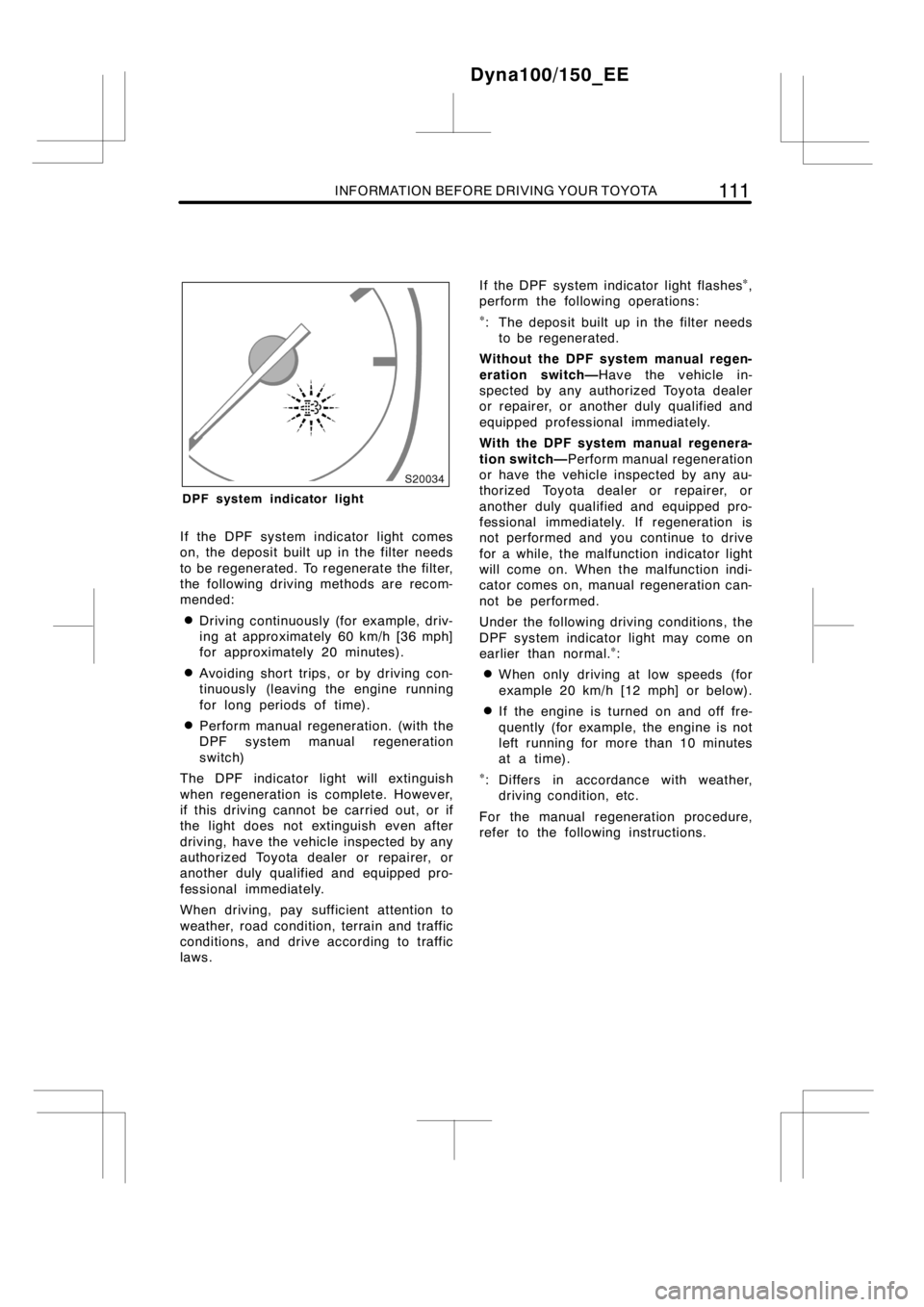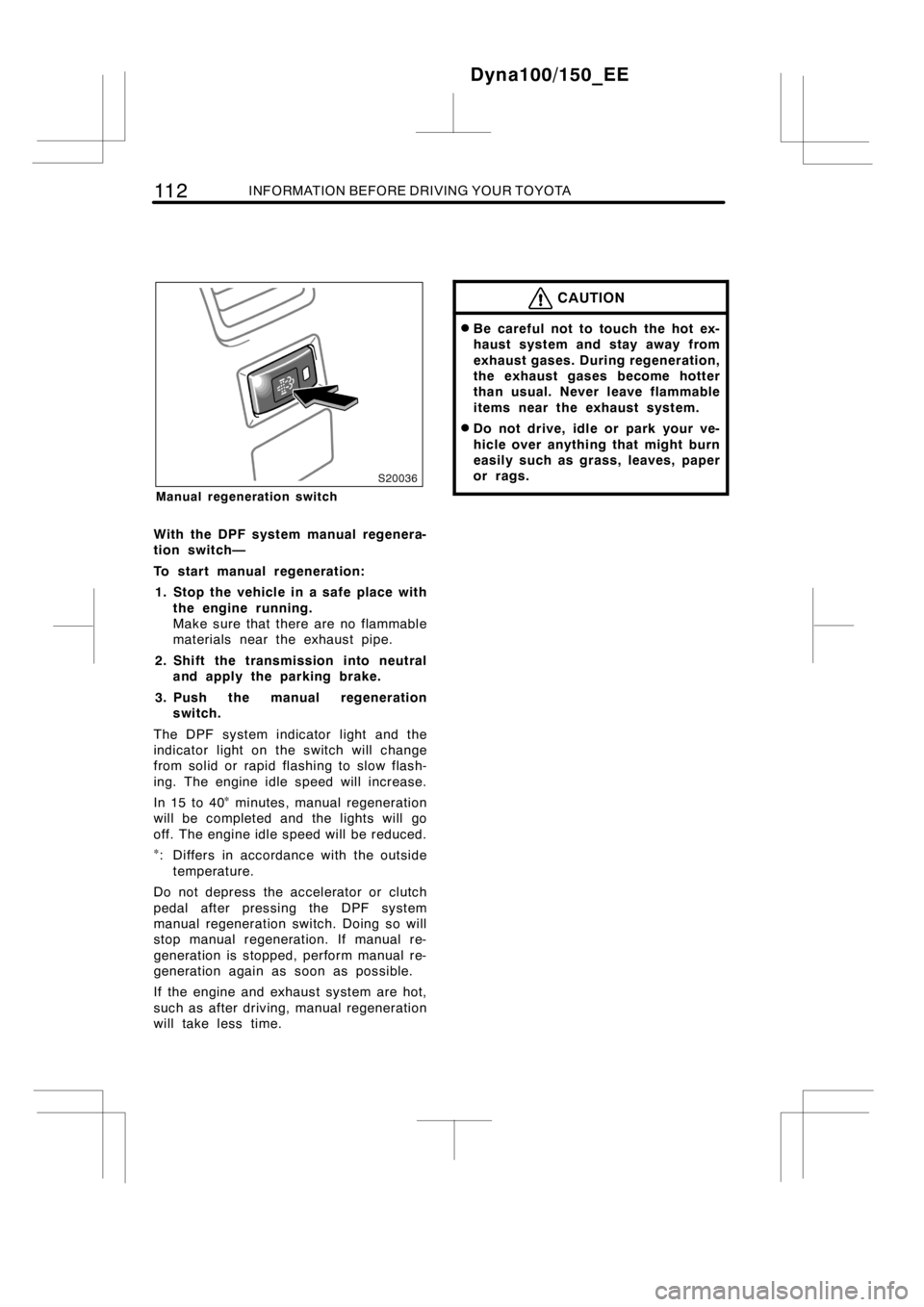Page 108 of 232
102OTHER EQUIPMENT
The cup holder is designed for holding
cups or drink−cans securely.
To use the cup holder, pull it out com-
pletely.
CAUTION
DDo not place anything else other
than cups or drink−cans in the cup
holder, as such items may be
thrown about in the compartment
and possibly injure people in the
vehicle during sudden braking or in
an accident. If possible, cover hot
drinks to prevent burns.
DTo reduce the chance of injury in
case of an accident or sudden stop
while driving, keep the cup holder
closed when it is not in use.
NOTICE
Left−hand drive vehicles only—
Always stow the cup holder in the
instrument panel before opening the
engine access hole cover. If this is
not done, the cover will hit the cup
holder and damage it.
To use the box, pull on the handle.
CAUTION
To reduce the chance of injury in
case of an accident or a sudden stop,
always keep the auxiliary box closed
while driving.
Dyna100/150_EE
Cup holder Auxiliary box
Page 111 of 232
OTHER EQUIPMENT105
CAUTION
Observe the following precautions.
Failure to do so may cause the driv-
er ’s floor mat to slip, possibly inter-
fering with the pedals while driving.
An unexpectedly high speed may re-
sult or it may become difficult to
stop the vehicle, leading to a serious
accident.
When installing the driver’s floor mat:
DDo not use floor mats designed for
other models or different model
year vehicles, even if they are
Toyota Genuine floor mats.
DOnly use floor mats designed for
the driver ’s seat.
DDo not use two or more floor mats
on top of each other.
DDo not place the floor mat bottom−
side up or upside−down.
Before driving:
DEnsure that the floor mat has been
placed correctly.
DWith the engine stopped and the
shift lever in neutral, fully depress
each pedal to the floor to make
sure it does not interfere with the
floor mat.
Dyna100/150_EE
Page 113 of 232
INFORMATION BEFORE DRIVING YOUR TOYOTA107
Section 2
INFORMATION BEFORE DRIVING YOUR
TOYOTA
DBreak−in period 108...................................
DFuel 108..............................................
DOperation in foreign countries 110.......................
DDPF system 110.......................................
DEngine exhaust cautions 114...........................
DFacts about engine oil consumption 115.................
DBrake system 116.....................................
DBrake pad wear indicators 119..........................
DLuggage stowage precautions 119......................
DLimited−slip differential 120.............................
DYour Toyota’s identification 120.........................
DSuspension and chassis 122............................
Dyna100/150_EE
Page 114 of 232

108INFORMATION BEFORE DRIVING YOUR TOYOTA
Drive gently and avoid high speeds.
Your vehicle does not need an elaborate
break−in. But following a few simple tips
for the first 1000 km (600 miles) can add
to the future economy and long life of
your vehicle:
DAvoid full throttle acceleration when
starting and driving.
DAvoid racing the engine.
DTry to avoid hard stops during the first
300 km (200 miles).
DDo not drive slowly with the manual
transmission in a high gear.
DDo not drive for a long time at any
single speed, either fast or slow.
DDo not tow a trailer during the first 800
km (500 miles).Selecting the proper fuel is essential
for satisfactory engine performance.
Engine damage caused by use of improp-
er fuels is not covered under Toyota’s new
vehicle warranty.
NOTICE
zDo not use improper fuels. If im-
proper fuels are used the engine
will be damaged.
zDo not use a fuel that contains
more than 50 ppm of sulfur. Use of
such a high sulfur fuel may damage
the engine.
zEU area: FAME (Fatty Acid Methyl
Ester) fuel sold under names such
as “B30” or “B100” and fuel
containing a large amount of FAME
should not be used. The use of
these fuels will damage the ve-
hicle’s fuel system. In case of any
doubt, ask any authorized Toyota
dealer or repairer, or another duly
qualified and equipped professional.
zExcept EU area: FAME (Fatty Acid
Methyl Ester) fuel sold under names
such as “B30” or “B100” and fuel
containing a large amount of FAME
should not be used. Your vehicle
can use diesel mixed with 5% max
biodiesel FAME (B5). The use of
fuel with more than 5% FAME con-
tent (B5) will damage the vehicle’s
fuel system. You must ensure that
refueling is carried out only from a
source where fuel specification and
quality can be guaranteed. In case
of any doubt, ask any authorized
Toyota dealer or repairer, or anoth-
er duly qualified and equipped pro-
fessional.
Dyna100/150_EE
Break−in period Fuel
Page 115 of 232

INFORMATION BEFORE DRIVING YOUR TOYOTA109
FUEL TYPE
Use only diesel fuel.
EU area:
Your vehicle must use only diesel fuel
conforming to European standard
EN590.
Except EU area:
Your vehicle must use only diesel fuel
that contains 50 ppm or less of sulfur
and has a cetane number of 48 or
higher.
CETANE NUMBER
Select cetane number 48 or higher.
Use of fuel with a cetane number lower
than stated will cause persistent heavy
knocking. If severe, this will lead to en-
gine damage.
If your engine knocks...
If you detect heavy knocking even when
using the recommended fuel, or if you
hear steady knocking while holding a
steady speed on level roads, consult any
authorized Toyota dealer or repairer, or
another duly qualified and equipped pro-
fessional.
However, occasionally, you may notice
light knocking for a short time while accel-
erating or driving up hills. This is normal
and there is no need for concern.FUEL TANK CAPACITY
L (gal., Imp. gal.)
Model
�Fuel tank capacity
KDY22160 (15.9, 13.2)
KDY231
KDY25180 (21.1, 17.6)
KDY261
�: See “Model code” on page vi in the
beginning of this manual if you are not
sure of your vehicle model.
Dyna100/150_EE
Page 116 of 232
11 0INFORMATION BEFORE DRIVING YOUR TOYOTA
If you plan to drive your Toyota in
another country...
First,comply with the vehicle registration
laws.
Second,confirm the availability of the cor-
rect fuel.The DPF (Diesel Particulate Filter) sys-
tem is designed to reduce the deposit
in diesel engine exhaust gases by trap-
ping the deposit in the filter. The sys-
tem performs automatic regeneration to
burn off the deposit trapped in the fil-
ter.
Regeneration
Regeneration is performed as necessary
in accordance with driving conditions.
System characteristics
The DPF system has the following charac-
teristics:
DIdle speed increases during regenera-
tion.
DThe smell of the exhaust gas differs
from that of a conventional diesel ve-
hicle.
Dyna100/150_EE
Operation in foreign
countriesDPF system
Page 117 of 232

INFORMATION BEFORE DRIVING YOUR TOYOTA111
DPF system indicator light
If the DPF system indicator light comes
on, the deposit built up in the filter needs
to be regenerated. To regenerate the filter,
the following driving methods are recom-
mended:
DDriving continuously (for example, driv-
ing at approximately 60 km/h [36 mph]
for approximately 20 minutes).
DAvoiding short trips, or by driving con-
tinuously (leaving the engine running
for long periods of time).
DPerform manual regeneration. (with the
DPF system manual regeneration
switch)
The DPF indicator light will extinguish
when regeneration is complete. However,
if this driving cannot be carried out, or if
the light does not extinguish even after
driving, have the vehicle inspected by any
authorized Toyota dealer or repairer, or
another duly qualified and equipped pro-
fessional immediately.
When driving, pay sufficient attention to
weather, road condition, terrain and traffic
conditions, and drive according to traffic
laws.If the DPF system indicator light flashes
�,
perform the following operations:
�: The deposit built up in the filter needs
to be regenerated.
Without the DPF system manual regen-
eration switch—Have the vehicle in-
spected by any authorized Toyota dealer
or repairer, or another duly qualified and
equipped professional immediately.
With the DPF system manual regenera-
tion switch—Perform manual regeneration
or have the vehicle inspected by any au-
thorized Toyota dealer or repairer, or
another duly qualified and equipped pro-
fessional immediately. If regeneration is
not performed and you continue to drive
for a while, the malfunction indicator light
will come on. When the malfunction indi-
cator comes on, manual regeneration can-
not be performed.
Under the following driving conditions, the
DPF system indicator light may come on
earlier than normal.
�:
DWhen only driving at low speeds (for
example 20 km/h [12 mph] or below).
DIf the engine is turned on and off fre-
quently (for example, the engine is not
left running for more than 10 minutes
at a time).
�: Differs in accordance with weather,
driving condition, etc.
For the manual regeneration procedure,
refer to the following instructions.
Dyna100/150_EE
Page 118 of 232

11 2INFORMATION BEFORE DRIVING YOUR TOYOTA
Manual regeneration switch
With the DPF system manual regenera-
tion switch—
To start manual regeneration:
1. Stop the vehicle in a safe place with
the engine running.
Make sure that there are no flammable
materials near the exhaust pipe.
2. Shift the transmission into neutral
and apply the parking brake.
3. Push the manual regeneration
switch.
The DPF system indicator light and the
indicator light on the switch will change
from solid or rapid flashing to slow flash-
ing. The engine idle speed will increase.
In 15 to 40
�minutes, manual regeneration
will be completed and the lights will go
off. The engine idle speed will be reduced.
�: Differs in accordance with the outside
temperature.
Do not depress the accelerator or clutch
pedal after pressing the DPFsystem
manual regeneration switch. Doing so will
stop manual regeneration. If manual re-
generation is stopped, perform manual re-
generation again as soon as possible.
If the engine and exhaustsystem are hot,
such as after driving, manual regeneration
will take less time.
CAUTION
DBe careful not to touch the hot ex-
haust system and stay away from
exhaust gases. During regeneration,
the exhaust gases become hotter
than usual. Never leave flammable
items near the exhaust system.
DDo not drive, idle or park your ve-
hicle over anything that might burn
easily such as grass, leaves, paper
or rags.
Dyna100/150_EE